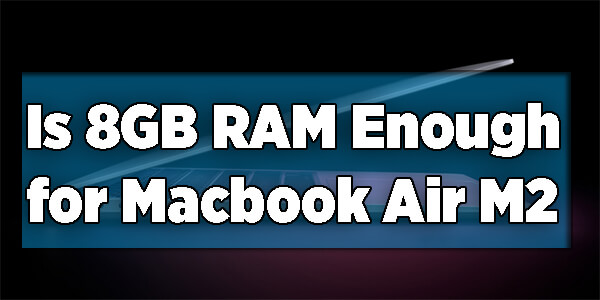The introduction of the M1 & subsequent M2 chips in the MacBook Air lineup marked a monumental shift in performance and efficiency. These chips not only redefined the capabilities of laptops but also sparked discussions about the role of RAM in these sleek machines.

The question at the forefront of many potential buyers’ minds is whether 8GB of RAM is adequate for harnessing the full potential of the MacBook Air M2 or M1. We delve into the intricacies of RAM, the capabilities of these remarkable chips, and the scenarios where 8GB might be enough or where more could be merited.
What is RAM & Its Importance?
Random Access Memory (RAM) is a vital component in any computer system, including Apple’s MacBook Air. It is responsible for temporarily storing data that the processor needs to access quickly. This data encompasses active applications, tasks, and cached files, which enable seamless multitasking and system responsiveness. The more RAM a system has, the better it can manage a multitude of tasks simultaneously.
8GB RAM: Performance Considerations –
When contemplating whether 8GB of RAM is sufficient for the MacBook Air M1 or M2, several factors come into play. These factors include the type of tasks you typically perform, the longevity you expect from your device, and the budget you’re working with.
Everyday Tasks –
For most everyday tasks such as web browsing, email, video streaming, and light document editing, 8GB of RAM is generally sufficient. The M1 and M2 chips are designed to handle these tasks smoothly even with moderate RAM.
Multitasking –
The real power of the M1 and M2 chips comes to the fore when you’re multitasking. With 8GB of RAM, you can comfortably work with multiple browser tabs, run productivity applications, and even dabble in light photo editing.
Macbook Pro 8gb Ram Vs 16gb:
The difference between a MacBook Pro with 8GB of RAM and one with 16GB can significantly impact multitasking, performance, and future usability.
8GB RAM:
- Good for everyday tasks and light multitasking.
- May struggle with heavy multitasking or resource-intensive applications.
- Could limit future software compatibility and longevity.
16GB RAM:
- Smooth multitasking even with demanding applications.
- Ideal for resource-intensive tasks like video editing and programming.
- Offers better performance, future-proofing, and an overall more capable experience.
In essence, while 8GB RAM suits casual use, 16GB provides better performance and prepares. Your MacBook Pro for future software demands and resource-intensive tasks.
Real-World Performance Comparison –
To understand the practical impact of RAM on MacBook Air M1 or M2 performance, let’s look at real-world scenarios:
Scenario 1: Light Usage –
For tasks like web browsing, email, word processing, 8GB of RAM is more than sufficient. These activities require minimal RAM & will run smoothly on the M1 or M2 chip with 8GB of RAM.
Scenario 2: Multitasking –
With 8GB of RAM, you can comfortably multitask between multiple applications. Such as having several browser tabs open while working on a document or spreadsheet. The M1 and M2 chips’ efficiency ensures smooth transitions between tasks.
Scenario 3: Creative Work –
For photo editing in applications like Adobe Lightroom or light video editing, 8GB of RAM can handle the load. However, if you’re engaging in extensive video editing with multiple layers or working on large projects in 3D design software, 16GB of RAM would be preferable.
Scenario 4: Future Software Updates –
Consider the longevity of your investment. As software evolves and becomes more sophisticated, it might require more RAM to function optimally. Having 16GB of RAM could provide a performance buffer for future software updates.
Conclusion: In the evolving landscape of computing, the MacBook Air M2 and M1 stand as prime examples of cutting-edge engineering. As we navigate the terrain of RAM requirements, it becomes clear that 8GB can certainly propel these laptops through a myriad of tasks. For the average user engaged in web browsing, media consumption, and general multitasking, 8GB provides a responsive and seamless experience.
However, the true allure of these machines shines brightest. When engaged in the more complex realms of creative work and heavy multitasking. For those with a penchant for video editing, graphic design, or a desire for future-proofing, the leap to 16GB might be a strategic move.
The MacBook Air M2 and M1, equipped with their stellar M-series chips, are poised to deliver exceptional performance whether adorned with 8GB or 16GB of RAM. The choice hinges on individual needs, aspirations, and the desire for a computing experience that marries power and efficiency in perfect harmony.
Also Read: 12GB RAM Vs 16GB RAM: Difference & Which is better for Gaming?
FAQs –
Question-1: Is 8GB RAM sufficient for everyday tasks on a MacBook Air M2/M1?
Answer: Yes, 8GB of RAM is generally adequate for everyday tasks like web browsing, email, and media on a MacBook Air M2 or M1. These chips are optimized to handle such tasks efficiently even with moderate RAM.
Question-2: Is 8GB RAM suitable for creative work like photo or video editing?
Answer: While 8GB of RAM can handle light creative work, such as basic photo editing, more intensive tasks like extensive video editing or working with large media files will benefit from 16GB of RAM for smoother operation and faster rendering.
Question-3: Will 8GB RAM be sufficient for software updates in the future?
Answer: While 8GB RAM can run current software effectively, future software updates might demand more memory. Having 16GB of RAM can ensure your MacBook Air M2/M1 remains capable of handling new software requirements without compromising performance.
Question-4: Can I upgrade RAM in a MacBook Air M2/M1 later?
Answer: No, Apple’s MacBook Air M2/M1 models have soldered RAM, meaning you cannot upgrade it after purchase. Thus, making the right RAM choice initially is important.
